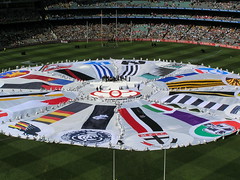 I know the rule is: write what you know. So, I also know I’m going out on a limb here writing something about sport. Specifically, writing about AFL. But, this idea has got into my head, and I think writing it down is the only way to let it out.
I know the rule is: write what you know. So, I also know I’m going out on a limb here writing something about sport. Specifically, writing about AFL. But, this idea has got into my head, and I think writing it down is the only way to let it out.
Due to utter chance, the weekend newspaper fell open on an article about the AFL competition format, and after glancing at it, I found it to be really interesting. The gist of it was that the AFL has consciously shaped its teams to create a level playing field, through salary caps and priority draft picks for bottom teams, with the result that there is a good rotation of teams winning the grand final, and the sport has achieved enduring popularity. And it doesn’t hurt that they’ve been able to translate that popularity into a pretty decent TV rights deal.
However, it appears that while there is a good rotation of top teams, in recent years, those top teams are typically (and curiously) much better than the rest of the competition. According to the article, since 2000, Essendon, then the Lions, Port Adelaide, Geelong, St Kilda and now Collingwood have had long runs of wins, trouncing all the other teams for a reasonable period of time.
It strikes me that another way that the AFL has shaped their competition may be leading to this very outcome: growing the number of teams. Despite their efforts to limit and reset the strength of the teams each season, there is always going to be a distribution of ability across the set of teams. A spread of ability will exist, even if concentrated, so there can still be outliers. To put it another way, even if the standard distribution is smaller, the probability of a team falling outside a s.d. of the mean is still the same.
According to Wikipedia’s page on the AFL, back in 1982 there were just 12 teams, and this has increased little-by-little over the years to the current 17 teams, with 18 teams are proposed for next year. If we look at the probability of there being an outperformer in the mix (for discussion’s sake, let’s define that as a team with an ability two standard deviations above the mean), it increases from about 1-in-4 for a 12 team competition to about 1-in-3 for an 18 team competition.
| # Teams | Year | P(one or more outperformers) |
|---|---|---|
| 12 | 1982 | 0.241 |
| 14 | 1987 | 0.275 |
| 15 | 1991 | 0.292 |
| 16 | 1995 | 0.308 |
| 17 | 2011 | 0.324 |
| 18 | 2012 | 0.339 |
On one hand, the AFL’s actions are intended to make teams as similar in ability as possible to promote healthy competition. Ironically though, it seems their actions in increasing the size of the competition might be working against this to improve the chance than a season will have a dominant team.
Although from the AFL’s point of view, if the driver of their policies is not competition but popularity, then as long as the new teams are introduced in new areas, the loss of popularity from impacting competition is likely more than made up by the increase due to the additional of new supporters.
